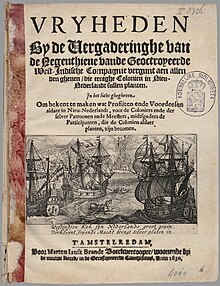This article includes a list of general references, but it lacks sufficient corresponding inline citations. (July 2013) |
| New Netherland series |
|---|
| Exploration |
| Fortifications: |
| Settlements: |
| The Patroon System |
|
| People of New Netherland |
| Flushing Remonstrance |
 |

In the United States, a patroon (English: /pəˈtruːn/; from Dutch patroon [paːˈtroːn]) was a landholder with manorial rights to large tracts of land in the 17th-century Dutch colony of New Netherland on the east coast of North America.[1] Through the Charter of Freedoms and Exemptions of 1629, the Dutch West India Company first started to grant this title and land to some of its invested members. These inducements to foster colonization and settlement (also known as the "Rights and Exemptions") are the basis for the patroon system. By the end of the 18th century, virtually all of the American states had abolished primogeniture and entail;[2] thus patroons and manors evolved into simply large estates subject to division and leases.
The deeded tracts were called patroonships and could span 16 miles in length on one side of a major river, or 8 miles if spanning both sides. In 1640, the charter was revised to cut new plot sizes in half, and to allow any Dutch American in good standing to purchase an estate. The title of patroon came with powerful rights and privileges. A patroon could create civil and criminal courts, appoint local officials and hold land in perpetuity. In return, he was required by the Dutch West India Company to – sources vary – establish a settlement of at least 50 families within four years on the land,[3] or "ship fifty colonists to it within four year".[4] As tenants working for the patroon, these first settlers were relieved of the duty of public taxes for ten years, but were required to pay rent to the patroon. A patroonship sometimes had its own village and other infrastructure, including churches.
Patroons were entitled to the acquisition of enslaved labor by the Dutch West India Company's Rights and Exemptions Charter. Patroons, often the wealthiest and most influential residents of New Netherland, procured and exploited slaves in almost every part of the colony, although a majority of the slave population remained near New Amsterdam, and farther north, were centered around Fort Orange (Albany, NY) and Rensselaerswijck. Moreover, patroons were essentially the only colonists in New Netherland to own slaves.[5]
After the English takeover of New Netherland in 1664 and American independence in 1783, the system continued with the granting of large tracts known as manors, and sometimes referred to as patroonships.
- ^ "Conditions as Created by their Lords Burgomasters of Amsterdam". World Digital Library. 1656. Retrieved 2013-07-28.
- ^ Katz, Stanley N. (November 1977). "Republicanism and the Law of Inheritance in the American Revolutionary Era". Michigan Law Review. 76 (1): 1–29. doi:10.2307/1287996. JSTOR 1287996. See p. 13.
- ^ books.google.com Eighteenth Annual Report of the Bureau of American Ethnology
- ^ newnetherlandinstitute.org
- ^ newnetherlandinstitute.org
